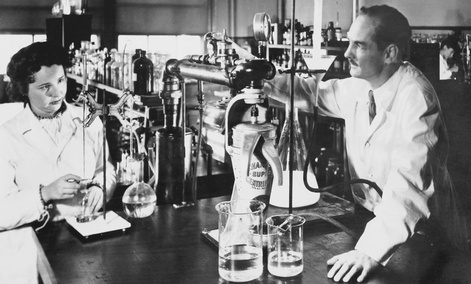
Gertrude Elion and George Hitchings in 1948 // Wikimedia Commons
Twenty-year-old Rosalyn Sussman cut a steely, solitary figure in September 1941 as she started her doctorate in nuclear physics at the University of Illinois Champaign-Urbana.
“I was the first woman to have a graduate assistantship in physics there since 1917,” she recounted to biographer Eugene Straus. She was the only female faculty member among 400, and there were no women’s bathrooms in the lab facilities—a major inconvenience, especially during the many nights she spent sleeping on the floor of the lab. Despite her confidence and persistence, even Rosalyn couldn’t have predicted that she would graduate several semesters early, make the jump to medicine, develop a revolutionary technique in the field of endocrinology, and win the Nobel Prize in Physiology or Medicine in 1977.
Decades later, there’s no question that Rosalyn Sussman Yalow (her married name) and Gertrude Elion, Yalow’s contemporary and fellow Nobel laureate, were trailblazers in medical research. Yalow helped develop a technique called radioimmunoassay, a highly sensitive method for measuring hormone levels in-vitro, and Elion developed many new drugs, including the precursor to the first drug to treat AIDS, AZT. They are two of only 10 women to ever win the Nobel Prize in Physiology or Medicine.
Many stories about pioneering women and minorities in science focus on their intrinsic determination to carry on in spite of setbacks. But there were two major external powers at work that helped propel Yalow and Elion. These elements—changes to the predominant, male-oriented culture around them and strong relationships with mentors across gender lines—are still highly relevant today, as women forge new paths in science, technology, engineering, and math (STEM) fields.
Continue reading at: http://www.nextgov.com/health/2014/10/female-pioneers-who-changed-stem-forever/97580/